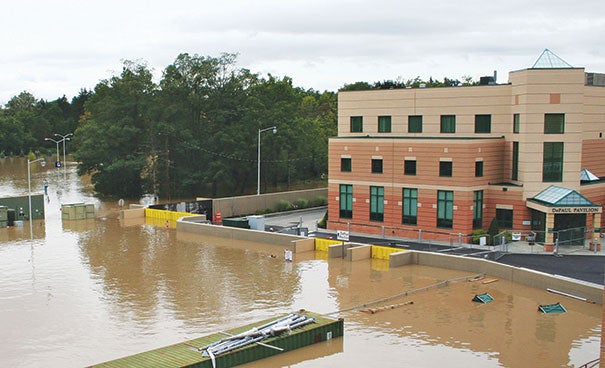Fed program to aid health care climate resiliency
 |
| PHOTO COURTESY OF OUR LADY OF LOURDES MEMORIAL HOSPITAL Flood walls protect Our Lady of Lourdes Memorial Hospital in Binghamton, N.Y., during flooding in the area. |
Health & Human Services (HHS) is urging health care systems to prepare for the impact of climate change and future outbreaks of severe weather like the ones that ravaged parts of the nation in recent years by making their facilities as resilient as possible.
To help achieve that goal, HHS launched the Sustainable and Climate Resilient Health Care Facilities Initiative to provide tools and information in the form of a guide and website.
The initiative, part of President Obama’s Climate Action Plan, was launched at a White House meeting in December attended by HHS leaders and other administration officials. The leaders of several hospitals across the United States and the American Hospital Association also attended the meeting to support the initiative and to encourage other hospitals to increase resiliency at their facilities.
Dale Woodin, CHFM, FASHE, senior executive director, American Society for Healthcare Engineering (ASHE), noted that AHA and ASHE have long supported integrating sustainable practices into the health care environment.
“Improving the resiliency of health care facilities to natural disasters and epidemics is part of nearly every discussion on health care facility planning and design,” Woodin says. “Each of these discussions focuses on preserving the core health care mission — providing patient care to those in need.”
To help health care facilities, ranging from multifacility campuses to single outpatient providers, HHS released at the White House meeting a guide titled “Primary Protection: Enhancing Health Care Resilience for a Changing Climate.” The guide focuses on:
• developing and maintaining data on climate hazards and infrastructure vulnerabilities;
• constructing or retrofitting infrastructure in a manner that is sustainable and better at withstanding future events;
• prioritizing resilience measures for high priority, vulnerable functions and areas.
It also offers best practices shared by hospitals and health care facilities that successfully have withstood severe weather by designing for resiliency.
The peer-reviewed report was co-authored by Robin Guenther, FAIA, sustainable health care design leader and principal at design firm Perkins+Will, New York City, and John Balbus, M.D., senior adviser for public health, National Institute of Environmental Health Sciences, Bethesda, Md.
“This guide allows people to see the whole picture of why hospitals fail in cold weather, hot weather, in storms, in tornadoes as well as understand what similar facilities have done to become more resilient,” says Guenther, a leading health care facility designer and sustainability advocate.
In addition, HHS is developing a suite of online resilience tools for health care facilities to supplement the Obama administration’s Web-based U.S. Climate Resilience Toolkit, which includes a topic called Building Climate Resilience in the Health Sector.
The new information, which will be available in coming months, will include health and health care-related fact sheets, resources and case studies on how facilities have addressed the range of climate change-related hazards. It also will offer more detailed guidance on affordable measures to ensure that the health care facilities are more resilient.
Together the guide and toolkit can assist health care providers, design professionals and others to assure the continuity of quality health and human care before, during and after extreme weather events across the spectrum of facilities from campuses to outpatient service providers and nursing homes.
The guide and toolkit are components of Obama’s Climate Action Plan launched in 2013.
More resources on this issue
Resources discussed in this article can be accessed through the following link:
• U.S. Climate Resilience Toolkit: http://toolkit.climate.gov/topics/human-health




